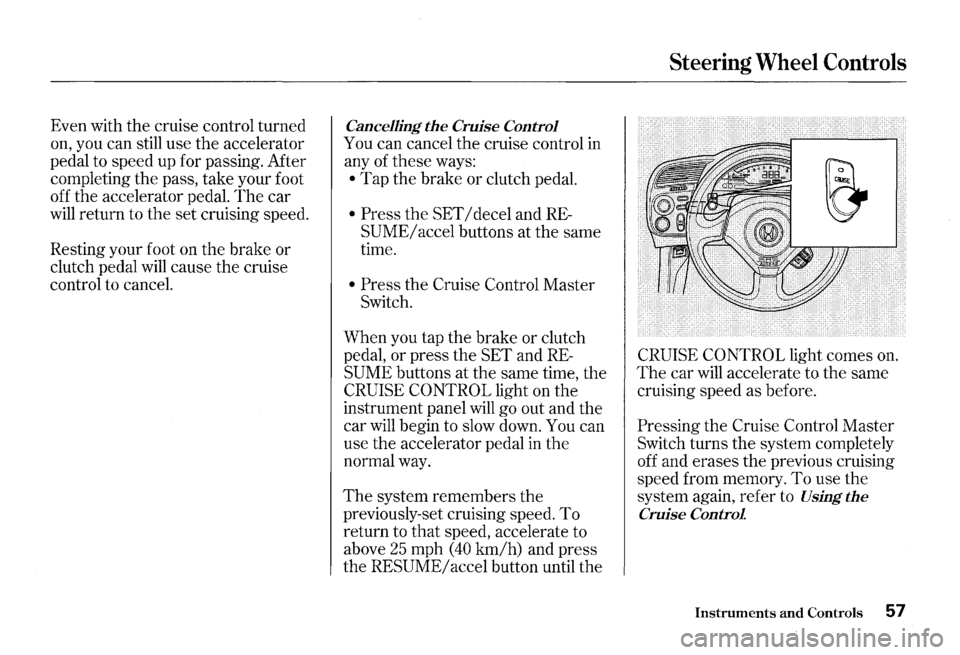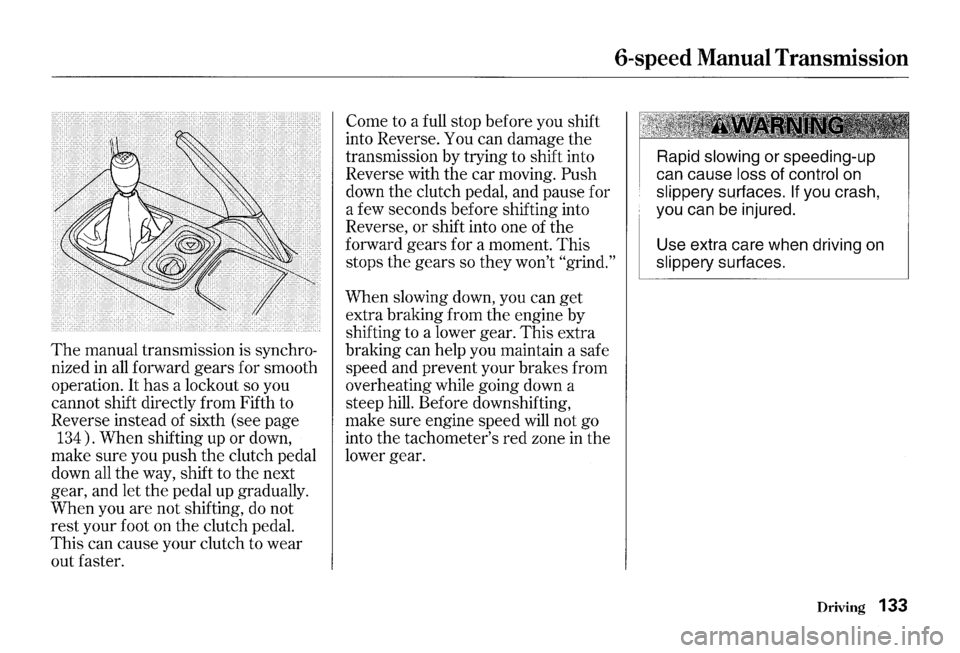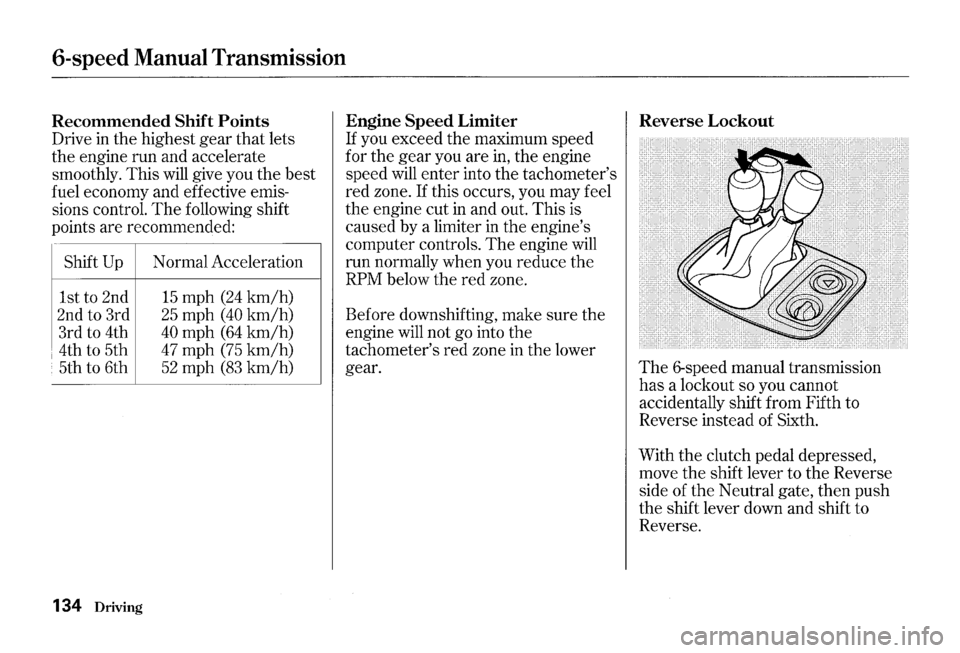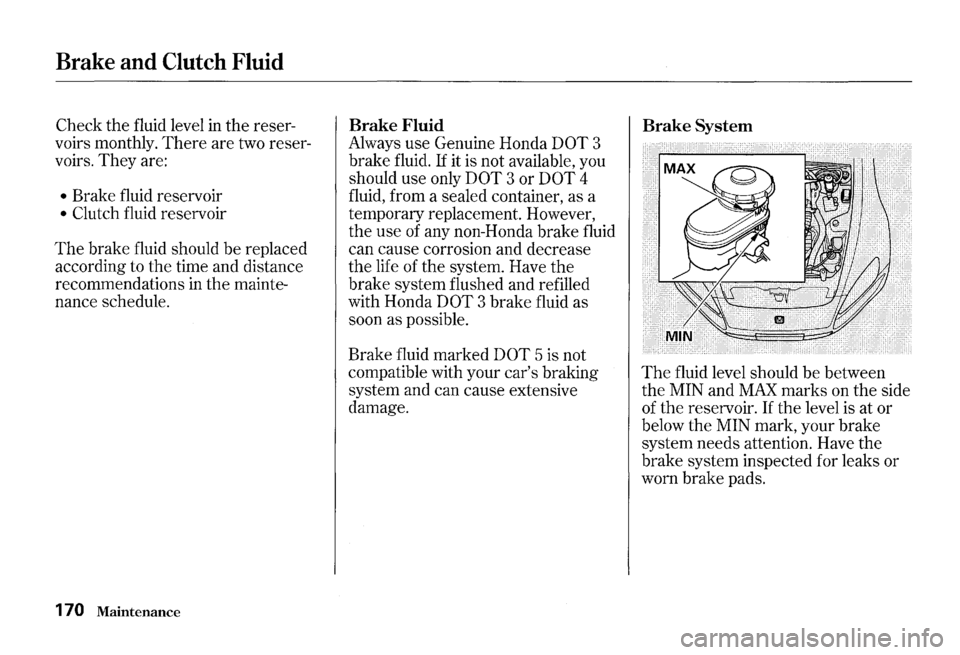2000 HONDA S2000 clutch
[x] Cancel search: clutchPage 59 of 273

Steering Wheel Controls
3. Press and release the SET I decel
button on the steering wheel.
The
CRUISE CONTROL light on the
instrument panel comes on to
show the system is now activated.
The cruise control may not hold
the set speed when you are going
up and down hills.
If your speed
increases going down a hill, use
the brakes to slow down to the
desired speed. This
will cancel the
56 Instruments and Controls
cruise control. To resume the set
speed, press the
RESUME/ accel
button.
The CRUISE CONTROL
light on the instrument panel
comes
on.
Changing the Set Speed
You can increase the set cruising
speed
in any of these ways:
• Press and hold the RESUME/
accel button. The car will acceler
ate. When you reach the desired
cruising speed, release the button.
• Push on the accelerator pedal. Ac
celerate to the desired cruising
speed and press the
SET I decel
button.
• To increase your speed in very
small amounts, tap the
RESUME/
accel button repeatedly. Each time
you
do this, your car will speed up
about 1 mph
(1.6 km/h).
You can decrease the set cruising
speed
in any of these ways:
• Press and hold the SET I decel
button.
The car will decelerate.
Release the button when you
reach the desired speed.
• To slow down in very small
amounts, tap the
SET I decel
button repeatedly. Each time you
do this, your car will slow down
about 1 mph
(1.6 km/h).
• Tap the brake or clutch pedal
lightly with your foot.
The
CRUISE CONTROL light on the
instrument panel
will go out.
When the car slows to the desired
speed, press
the SET I decel button.
The car will then maintain the
desired speed.
Page 60 of 273

Even with the cruise control turned
on, you can still use the accelerator
pedal to speed up for passing. After
completing the pass, take your foot
off the accelerator pedal.
The car
will return to the set cruising speed.
Resting your foot on the brake or
clutch pedal
will cause the cruise
control to cancel.
Cancelling the Cruise Control
You can cancel the cruise control in
any
of these ways:
• Tap the brake or clutch pedal.
• Press the SET I decel and RE
SUME/ accel buttons at the same
time.
• Press the Cruise Control Master
Switch.
When you tap the brake or clutch
pedal, or press the SET and
RE
SUME buttons at the same time, the
CRUISE CONTROL light on the
instrument panel will
go out and the
car
will begin to slow down. You can
use the accelerator pedal in the
normal way.
The system remembers the
previously-set cruising speed. To
return to that speed, accelerate to
above
25 mph (40 km/h) and press
the
RESUME/ accel button until the
Steering Wheel Controls
CRUISE CONTROL light comes on.
The car will accelerate to the same
cruising speed as before.
Pressing the Cruise Control Master
Switch turns the system completely
off and erases the previous cruising
speed from memory.
To use the
system again, refer to
Using the
Cruise Control
Instruments and Controls 57
Page 134 of 273

1. Apply the parking brake.
2. In cold weather, turn off all
electrical accessories to reduce
the drain on the battery.
3. Push the clutch pedal down all the
way. The ENGINE SfARTbutton
has no effect unless the clutch
pedal is depressed.
4. Turn the ignition key to ON (II)
position.
5. Without touching the accelerator
pedal, push
the ENGINE Sf ART
button.
If the engine does not start
right away, do not hold the
ENGINE Sf ART button for more
than
15 seconds at a time. Pause
for at least 10 seconds before
trying again.
Starting the Engine
6. If the engine does not start within
15 seconds, or starts but stalls
right away, repeat step 5 with
the
accelerator pedal pressed half-way
down.
If the engine starts, release
pressure on the accelerator pedal
so
the engine does not race.
7. If the engine still does not start,
press the accelerator pedal all the
way down and hold it there while
starting in
order to clear flooding.
As before, hold
the ENGINE
Sf ART button for no more than
15 seconds. Return to step 6 if the
engine does not start. If it starts,
lift your foot off
the accelerator
pedal so
the engine does not race.
Driving 131
Page 136 of 273

The manual transmission is synchro
nized
in all forward gears for smooth
operation.
It has a lockout so you
cannot shift directly from Fifth to
Reverse instead of sixth (see page
134). When shifting up or down,
make sure you push the clutch pedal
down all the way, shift to the next
gear, and let the pedal up gradually.
When you are not shifting,
do not
rest your foot on the clutch pedal.
This can cause your clutch to wear
out faster.
6-speed Manual Transmission
Come to a full stop before you shift
into Reverse.
You can damage the
transmission by trying to shift into
Reverse with the car moving.
Push
down the clutch pedal, and pause for
a few seconds before shifting into
Reverse, or shift into one of the
forward gears for a moment. This
stops the gears so they won't
"grind."
When slowing down, you can get
extra braking from the engine by
shifting to a lower gear. This extra
braking can help you maintain a safe
speed and prevent your brakes from
overheating while going down a
steep hill. Before downshifting,
make sure engine speed will not go
into the tachometer's red zone
in the
lower gear.
Rapid slowing or speeding-up
can cause
loss of control on
slippery surfaces. If you crash,
you can be injured.
Use extra care when driving
on
slippery surfaces.
Driving 133
Page 137 of 273

6-speed Manual Transmission
Recommended Shift Points
Drive in the highest gear that lets
the engine run and accelerate
smoothly. This
will give you the best
fuel economy and effective emis
sions control.
The following shift
points are recommended:
Shift
Up Normal Acceleration
1st to 2nd
15 mph (24 km/h)
2nd to 3rd 25 mph (40 km/h)
3rd to 4th 40 mph (64 km/h)
4th to 5th 47 mph (75 km/h)
5th to 6th 52 mph (83 km/h)
134 Driving
Engine Speed Limiter Reverse Lockout
If you exceed the maximum speed
for the gear you are in, the engine
speed will enter into the tachometer's
red zone. If this occurs, you may feel
the engine cut
in and out. This is
caused by a limiter in the engine's
computer controls.
The engine will
run normally when you reduce the
RPM below the red zone.
Before downshifting, make sure the
engine will not go into
the
tachometer's red zone in the lower
gear.
The 6-speed manual transmission
has a lockout so you cannot
accidentally shift from Fifth to
Reverse instead of Sixth.
With the clutch pedal depressed,
move
the shift lever to the Reverse
side of
the Neutral gate, then push
the shift lever down and shift to
Reverse.
Page 146 of 273

This section explains why it is
important to keep your car well
maintained and to follow basic
maintenance safety precautions.
This section also includes
Maintenance Schedules for normal
driving and severe driving conditions,
a Maintenance Record, and instruc
tions for simple maintenance tasks
you may want to take care of
yourself.
If you have the skills and tools to per
form more complex maintenance
tasks on your Honda, you may want
to purchase
the Service Manual. See
page 259 for information on how to
obtain a copy,
or see your Honda
dealer. Maintenance
Safety .......................
144
Important
Safety Precautions .. 145
Maintenance Schedule .................. 146
Required Maintenance Record
.... 153
Owner Maintenance Checks ........ 155
Fluid Locations ............................... 156
Engine Oil ....................................... 157
Adding Oil... ................................ 157
Recommended Oil ..................... 157
Synthetic
Oil ............................... 158
Additives ..................................... 158
Changing the Oil and Filter.. .... 159
Cooling System .............................. 161
Adding Engine Coolant ............. 161
Replacing Engine Coolant ........ 163
Windshield Washers ..................... 167
6-speed Manual Transmission
Fluid ............................................
168
Differential Fluid ........................... 169
Brake and Clutch Fluid ................. 170
Brake Fluid ................................. 170
Brake System ............................. 170
Clutch System ............................ 171
Air Cleaner Element.. .................... 172
Hood Latch ..................................... 174
Maintenance
Spark Plugs ..................................... 174
Replacement ............................... 17 4
Specifications ............................. 176
Battery ............................................
177
Wiper Blades .................................. 180
Air Conditioning System ............... 182
Air Conditioning Filter, ................. 183
Drive Belt ........................................ 184
Tires ................................................ 185
Inflation ....................................... 185
Inspection ................................... 187
Maintenance ............................... 188
Tire Rotation .............................. 188
Tire Wear .................................... 188
Replacing Tires and Wheels .... 189
Wheels and Tires ....................... 190
Winter Driving ........................... 190
Snow
Tires .............................. 191
Tire Chains ............................. 191
Lights .............................................. 192
Replacing Bulbs ......................... 194
Storing Your Car ............................ 202
Maintenance 143
Page 158 of 273

You should check the following
items at the specified intervals.
If
you are unsure of how to perform
any check, turn to the page given.
• Engine oil level -Check every
time you
fill the fuel tank. See
page 119.
• Engine coolant level -Check the
radiator reserve tank every time
you
fill the fuel tank. See page 120 .
• Windshield washer fluid -Check
the level in the reservoir monthly.
If weather conditions cause you to
use the washers frequently, check
the reservoir each time you stop
forfuel. See page 167.
• Brakes and clutch -Check the
fluid level monthly. See page
170 .
Owner Maintenance Checks
• Tires -Check the tire pressure
monthly. Examine the tread for
wear and foreign objects. See page
186.
• Lights -Check the operation of
the headlights, parking lights,
taillights, high-mount brake light,
turn signals, brake lights, and
license plate lights monthly. See
page 192.
Maintenance 155
Page 173 of 273

Brake and Clutch Fluid
Check the fluid level in the reser
voirs monthly.
There are two reser
voirs.
They are:
• Brake fluid reservoir
• Clutch fluid reservoir
The brake fluid should be replaced
according to the time and distance
recommendations in
the mainte
nance schedule.
170 Maintenance
Brake Fluid Brake System
Always use Genuine Honda DOT 3
brake fluid.
If it is not available, you
should use only
DOT 3 or DOT 4
fluid, from a sealed container, as a
temporary replacement. However,
the use of any non-Honda brake fluid
can cause corrosion and decrease
the life of the system. Have
the
brake system flushed and refilled
with Honda
DOT 3 brake fluid as
soon as possible.
Brake fluid marked
DOT 5 is not
compatible with your car's braking
system and can cause extensive
damage.
The fluid level should be between
the MIN and
MAX marks on the side
of the reservoir. If the level is at or
below the MIN mark, your brake
system needs attention. Have the
brake system inspected for leaks or
worn brake pads.